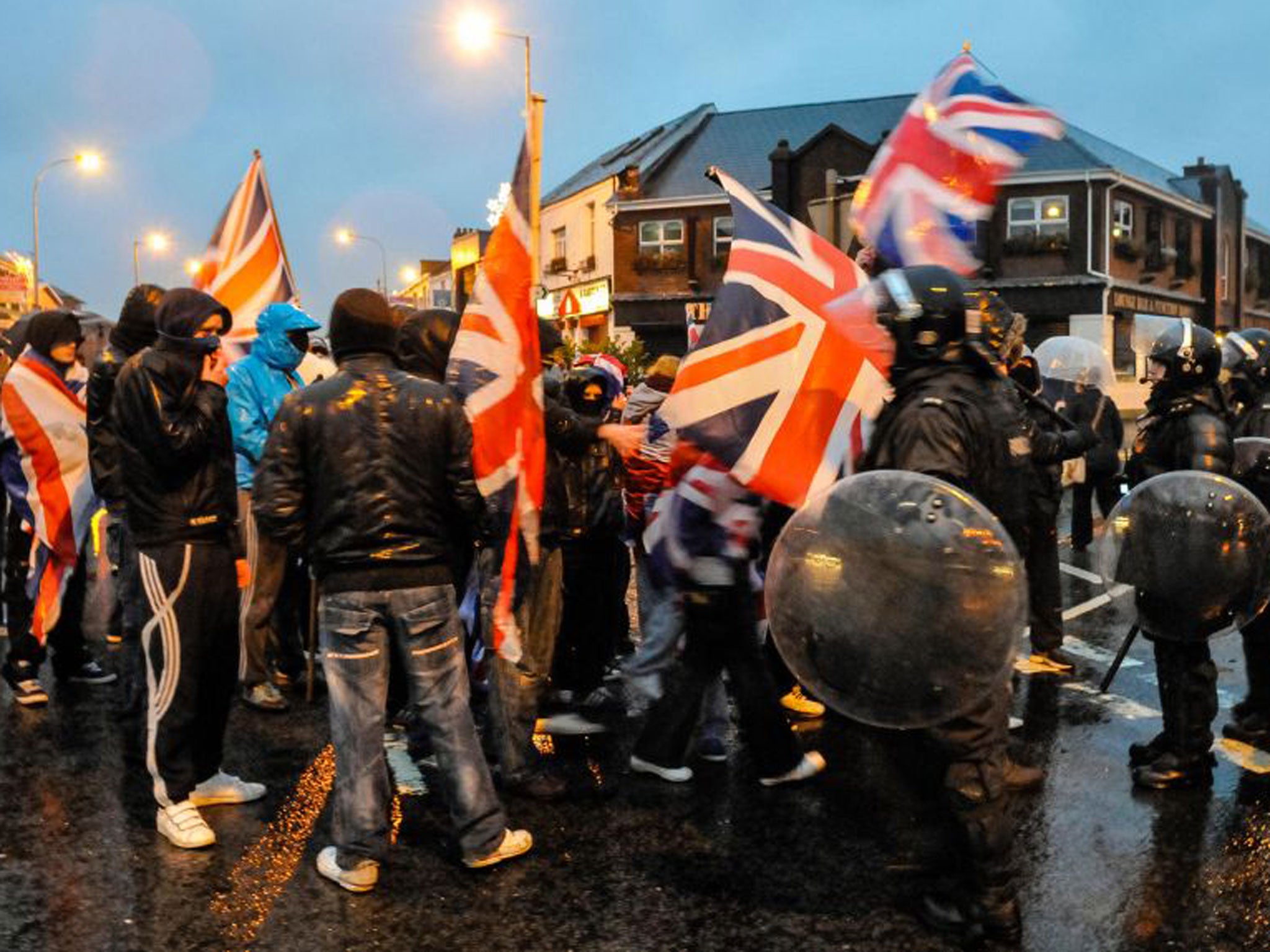Unflagging hatred: the new symbol of violence in Belfast
David McKittrick reports on a community that feels it is losing control and status

Your support helps us to tell the story
From reproductive rights to climate change to Big Tech, The Independent is on the ground when the story is developing. Whether it's investigating the financials of Elon Musk's pro-Trump PAC or producing our latest documentary, 'The A Word', which shines a light on the American women fighting for reproductive rights, we know how important it is to parse out the facts from the messaging.
At such a critical moment in US history, we need reporters on the ground. Your donation allows us to keep sending journalists to speak to both sides of the story.
The Independent is trusted by Americans across the entire political spectrum. And unlike many other quality news outlets, we choose not to lock Americans out of our reporting and analysis with paywalls. We believe quality journalism should be available to everyone, paid for by those who can afford it.
Your support makes all the difference.Every few months they emerge from the loyalist undergrowth – masked Protestant youths whose bricks, bottles, stones and petrol-bombs put police officers in hospital.
They are a lost generation, largely untouched by a peace process which has improved life for the rest of Belfast. They reach for the bricks because they feel they have no stake in society and harbour great resentment against a changing world. The dispute over flying the Union Flag at the city hall is just the latest in a series of flare-ups.
Some of them are members of loyalist paramilitary organisations but many are not. "I recognise a whole lot of them," said a loyalist ex-prisoner. "They're a rabble. Some of them have been expelled by the paramilitary groups, or they're druggies or criminals."
While most Protestants and unionists have a deep and genuine attachment to the Union Flag, for the youths in hoods such disputes are mere excuses to indulge in bother. Every marching season they take to the streets for what is called "recreational rioting".
Generally unemployed, they readily attack police lines and inflict injuries, completely heedless of the damage they do to the unionist cause and to the image of Northern Ireland.
This has been the year of a big tourism push, with Hillary Clinton visiting the new Titanic building yesterday to showcase the new Belfast. But the narrative of a much-improved city will be marred by riot and discord. Rioting carries few risks for the rioters. Police fire plastic baton rounds and make some arrests, but those involved rarely get hurt, are rarely prosecuted and, if convicted, rarely receive long sentences. Those who do appear in court are often pathetic specimens, their lawyers pleading that they are easily led and have often consumed large amounts of drink and drugs.
Another potent element in the mix is the persistence of illegal groups, in particular the Ulster Volunteer Force. While this and other armed groups are now much less active, the UVF is worried because of its sense that a police "cold case" team is closing in on it.
A former member has agreed to become a supergrass and to testify against more than a dozen of its leaders, accusing them of a string of murders. Some outbreaks of rioting have been encouraged by the UVF as warnings to the authorities that such prosecutions will bring a violent reaction.
Loyalists have always put up the Union Flag and other emblems on telegraph poles and street lights, but the message they convey has changed greatly. Once viewed as proclamations of supremacy over Catholics, they now are seen in many places as acts of defiance in the face of shrinking Protestant numbers in Belfast.
They are put on display, by paramilitaries and local hard men, as a warning to Catholics not to move into Protestant territory. That they are left in place is an indication they are emblems of sectarianism rather than proclamations of Britishness.
It is the steady drop in the Protestant population which meant that unionists lost their majority on the council and thus lost the vote on flag-flying. The sense of loss is widespread within working-class loyalism, where a familiar refrain is that "the Catholics are getting everything, we get nothing".
While republicanism has produced formidable leaders in Gerry Adams and Martin McGuinness, attempts by loyalists to emulate Sinn Fein have come to nothing. The major unionist parties are meanwhile viewed as middle-class and out of touch.
Those in the ghettos have lost any sense of control over the city, and with it much of the pride they used to have. A sense of communal dejection is evident: unemployment is high and social problems such as drug use and youthful suicides are rife.
The once plentiful jobs in shipbuilding and heavy engineering are long gone, while the education record of young ghetto Protestant males remains poor: only a few make it to grammar school, and fewer still to college.
Those who do succeed educationally generally move out of the ghettos into more congenial areas where drugs, debt and paramilitarism and criminality are not constant problems.
Those who are left behind in hardline areas such as the Shankill and Woodvale are thus left without local role models, and with little hope of material progress. On top of this is the ingrained sectarianism which produces a belief that by comparison Catholics are making progress in many areas.
This means that symbolic issues such as the flying of flags and the right of loyalists to march past Catholic areas assume great importance, since they are seen as some of the few remaining vestiges of loyalist power.
Join our commenting forum
Join thought-provoking conversations, follow other Independent readers and see their replies
Comments